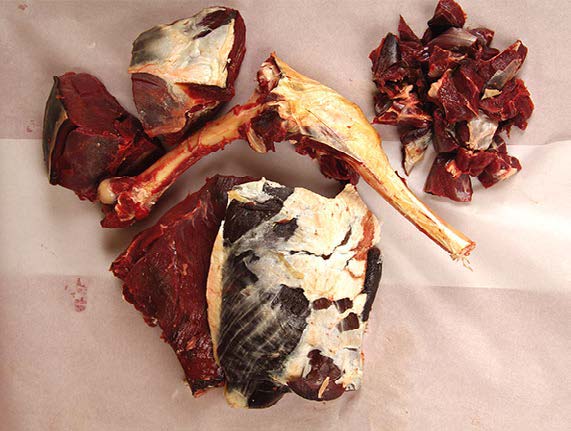Processing your whole animal from field to table can provide a rewarding outcome
For me, processing a whole deer and bringing it from the field to the table is a real source of pride. Years ago, my Dad remarked about his thinking that there aren’t too many folks who can do that. He continued, “You took the training and got the license; purchased a firearm and learned to shoot it accurately; hand-loaded custom hunting cartridges; found a place to hunt and negotiated access. You learned about animal behavior; hunted, stalked, and cleanly killed a wild animal; field dressed it, butchered it, grilled it, carved it, and now you are serving it.”
For me, hunting pride is passing a freshly grilled whole loin of medium rare venison, cut in diagonal pieces, to family and friends around our noisy table. I beam with pride when they say this is the best venison they have ever had, even if it is their first experience with wild meat. The hunters among the diners either want to know what I did to make it this good––or they already know and smile quietly to themselves. Someone close to these hunters let them in on the secret.
Impress with your next meal by following this guide for processing deer!
Field Dressing
The truth is that there is no secret to proper field dressing, just three rules that are simultaneously simple and challenging:
- Make it a quick That’s our responsibility as hunters. It is challenging to learn and practice the skills to become an expert marksman and a disciplined hunter, choosing not to take an iffy shot even when you can nearly taste those venison steaks. The best life for a wild animal is being wild. The best end to a wild animal’s life is at the hand of a responsible and competent hunter. It’s our responsibility.
- Field dress Keep the carcass clean and get it cold fast––the faster the better. The challenging part of field dressing is that the field is not a clean butcher shop. The exact location where you take the animal, the time of day and the time of year often make for an interesting puzzle to solve. The “exact location” refers to the place where your trophy comes to rest. My buddy dropped a bull elk in a mud puddle that would swallow your car. Later that same season, my brother shot a moose that had time to run across the creek to expire on an island. A few years ago, my moose dropped halfway to the ground and wedged between two poplar trees. That required me to cut one tree down to get at the moose. Each successful hunting trip morphs into a three-dimensional puzzle. They are sometimes simple and sometimes challenging to solve. Plan, find the right tools, and do the work required correctly. Clean, quick and safe are the three concepts that guide this part of the process.
- Avoid Our goal is to have the best venison possible for the table, which means avoiding meat spoilage. The moist, protein-rich, just-killed ungulate will be body temperature. That means its temperature is perfect for bacteria growth, so time is ticking from the moment you pull the trigger (or release that arrow). There are two things you control as a hunter that will help ensure the best venison for the table: keep it clean and dress it quickly. As soon as the animal is field dressed, get the meat as cool as possible. Depending on where we are hunting and the time of year, we might hang quarters of deer in the trees to cool in the breeze. In winter, it is much simpler to get the carcass chilled and keep it that way.
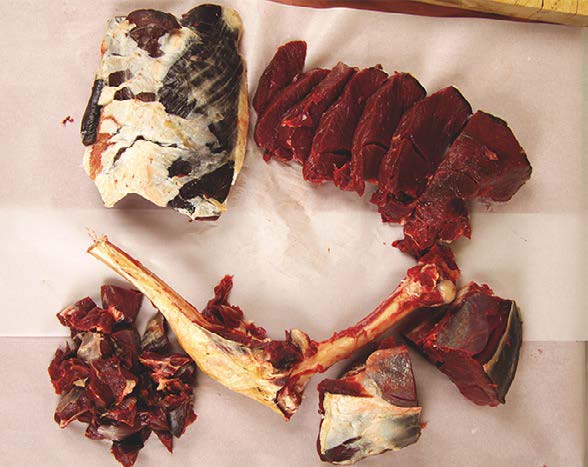
Butchering
For my hunting crew, butchering happens after the hunt, when we are back home.
My buddy shot a fine Whitetail buck before 10:00 a.m. on the last day of November this past year. He was impressed with the simplicity and speed of the field dress, and on our way home he said, “So what’s the best part of the deer?” That was followed by, “Where do you take your deer to get it cut up?”
I replied to him, “Every part of the deer is special, especially when we cut it up ourselves. Today, I will explain how to precisely cut each piece and how to cook it.”
Here is what I told him. First, it helps me to think about how tender the meat is by body part, while at the same time thinking about what dishes these various parts and cuts will be used in. Shoulders and shanks work hard and are tough as tennis balls. Loins and the largest leg muscles are comparatively tender. I like to think there are only two kinds of cuts: tender and tough. The tenderest cuts will be cooked quickly on a grill or roasted, the tougher cuts will get slow low moist heat.
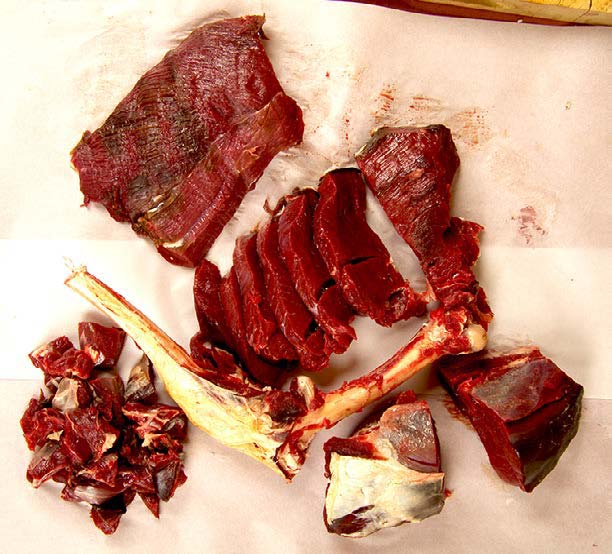
Tender Cuts
Inside the chest cavity between the hips and along the spine are two small tenderloins–premium meat. Using your knife and fingers, gently cut and pull the two separate pieces of tenderloin away from the spine. This is the most special and tender piece of the whole animal. Treat it with care. You’re either going to share this with someone special or eat the whole thing yourself.
The second most tender and special pieces are the two loins. Cut along the backbone from the shoulder to the hip, using the spine as a guide. These are also premium pieces. Using the ribs as a guide, ease your knife followed by fingers to loosen and cut away the loin in one big piece. When this chunk is cut clear, remove the layer of fat by pulling it off in one long pull. Use a flexible boning knife to assist if required, just like filleting the skin of a fish. Cut off the remaining silvery layer of the membrane the same way and toss it.
Next is the leg. Remove it. No need for a saw. Follow the seam of muscle at the front of the thigh towards the backbone using the bone as a guide to get to the hip socket. From the other side, slide your knife in at the base of the tail and work back to the socket. Pushing the leg away from the backbone, giving you access to the socket, cut it free. Move the leg to the cutting board. Now you have the highest concentration of excellent meat for use as steaks, roasts, and stew.
Legs come apart in three main pieces (muscles) and some trim that is perfect for stew meat. I say the legs come with cutting instructions. Follow the seams and cut between the big muscles to separate the leg into three large pieces of meat. The meat from below the knee bone is good for stew, or, if you want to get fancy (which I do), take the saw and cut the bone crosswise in two-inch wide chunks to be used for Venison Osso Bucco. These three largest muscles are each perfect for roasts, steak, and premium cubed meat for quick-cooking skewers. (See the photos for how I do this.)
May I suggest putting a whole leg away for Christmas dinner, or any other feast you will be hosting in the next few months? It is tough to beat whole leg roast for an impressive culinary treat for some important celebration.
Tough Cuts
The less tender meat comes from what’s left: front legs and shoulders. If you haven’t done this before, you will be surprised to see the front leg is attached by muscle only. Lift the front leg away from the carcass and slide your boning knife under the leg cutting between the leg/ shoulder and the ribs, as close to the ribs as possible. Cut up through and out the top, removing the foreleg/ shoulder. You can’t make a mistake here because this meat will be stewed or ground and blended with 30 percent pork shoulder to make sausage. Once the foreleg is removed, place it “outside up” on the cutting board. Cut along the ridge of the shoulder blade using the bone as a guide to slide your flexible knife along. Remove these pieces for stew chunks or grinding for burger or sausage. If you like meals like Swiss Steak, cut some steaks for slow cooking. I buy 25-pound bags from the butcher supply shop and use these to freeze the trim in 14-pound batches. Sometime after hunting season is finished, our family makes our sausage. Whether you make your own or use your favorite sausage maker, trimmed meat in 14-pound bags is the perfect size for 20-pound batches of sausage. (We add 6 pounds of pork shoulder to make 20-pound batches of sausage.)
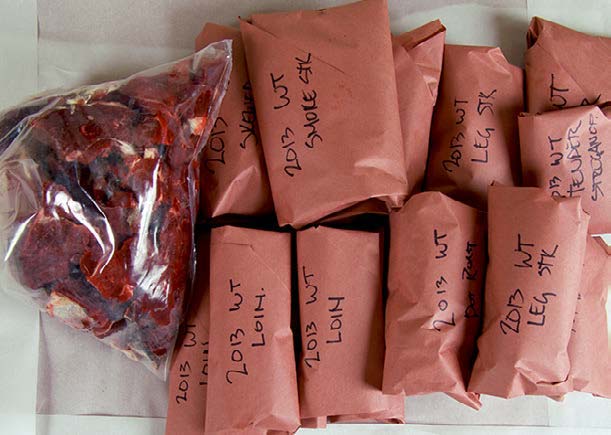
Ribs and Bones
We have found that deer ribs are perfect slow-smoked, just the way you would smoke a rack of pork ribs, with your favorite barbeque sauce. Save the bones from trimming to make bone broth or soup stock.
Now You Know
Carving a deer is simple. Once you are proficient at it, processing a deer can take less than an hour. You will add another step of immense pride in the hunting process by custom-cutting your animal into boneless meal-ready portions.
Now you are part of the elite group that knows the secret. A few select and special folks know how to do this. Take a moment to be proud of yourself.
GET THE RIGHT TOOLS FOR PROCESSING DEER
The specialized job of butchering your animals requires specialized tools. (You may already have some of these tools in your kitchen.) Add what you need to ensure you are well-equipped and can work efficiently. Starting with the small ax bottom left, and working clockwise. here are the tools I have come to love using for deer processing. (Note: asterisked items ride in my pack.)
- Small Wetterlings Ax* This tool is the smallest Wetterlings makes, perfect for severing the neck bones and splitting ribs, if required. Turned on its side, it makes a perfect implement to hammer out a cutlet. It’s also the perfect tool to split kindling to cook that cutlet for a hunter’s lunch. I keep a heavy cleaver in the knife drawer for home use and butchering. (Not pictured.)
- Knife Sharpener* This tiny sharpener rides in my pack to help me keep a keen edge on my blades. It easily fits in a shirt pocket.
- Ulu by Knives of Alaska* This is a modern version of the ancient skinning and butch- ering tool of the Inuit. It works!
- “Curved 5” Steak Knife* This particular knife is the one I use most in the field for separating muscles and bone. The leather sheaths for this knife and the long boning knife are custom-made by a local leather worker.
- Muskrat Suregrip by Knives of Alaska* This little beauty is another recent addition. The short, rounded blade is razor sharp and extends around the tip––perfect for fleshing in tight spots
- Flexible boning knife 6-inch This knife remains in my kitchen to be used for fine butchering work.
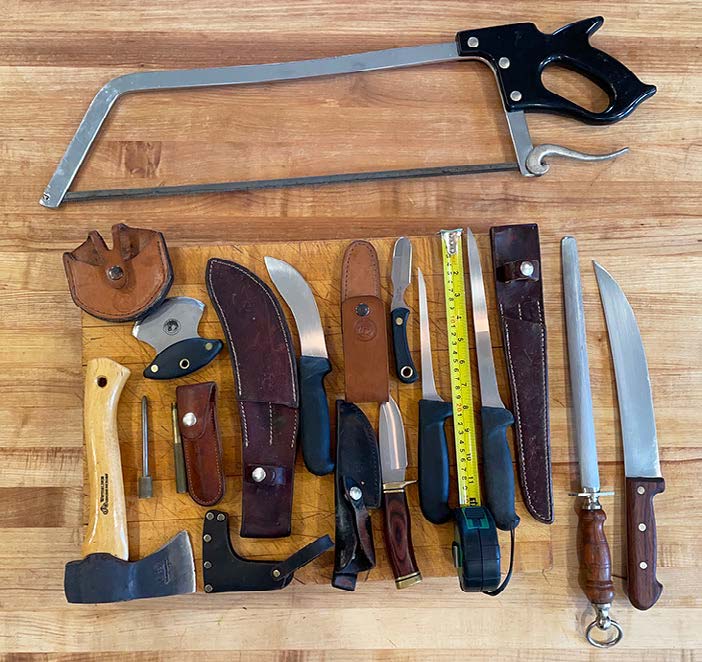
- Flexible Boning Knife 8-inch* This knife functions both as a fillet knife and a boning knife. It joins me on both hunting and fishing trips and is long enough to tackle a bull moose loin.
- Buck Vanguard* This is the first hunting knife I purchased 20-plus years ago, and I wear it on my hip every trip.
- Steel This steel is 40+ years old. It was purchased on my first day of culinary training. Contrary to what many folks believe, the role of a steel is not to sharpen––it is just to maintain an edge. The steel is always within easy reach when butchering to bring back the knife edge between proper sharpening.
- Butcher Knife Knives like this one are also known as steak knives. Their role is to cut perfectly even steaks from the loin or leg and to sever big muscles cleanly.
- Hand Meat Saw My local butcher and packer shop was where I found this. My butchering process uses very little saw work. The saw is used to cut Osso Bucco and to sever ribs for BBQ.
Per our affiliate disclosure, we may earn revenue from the products available on this page. To learn more about how we test gear, click here.



